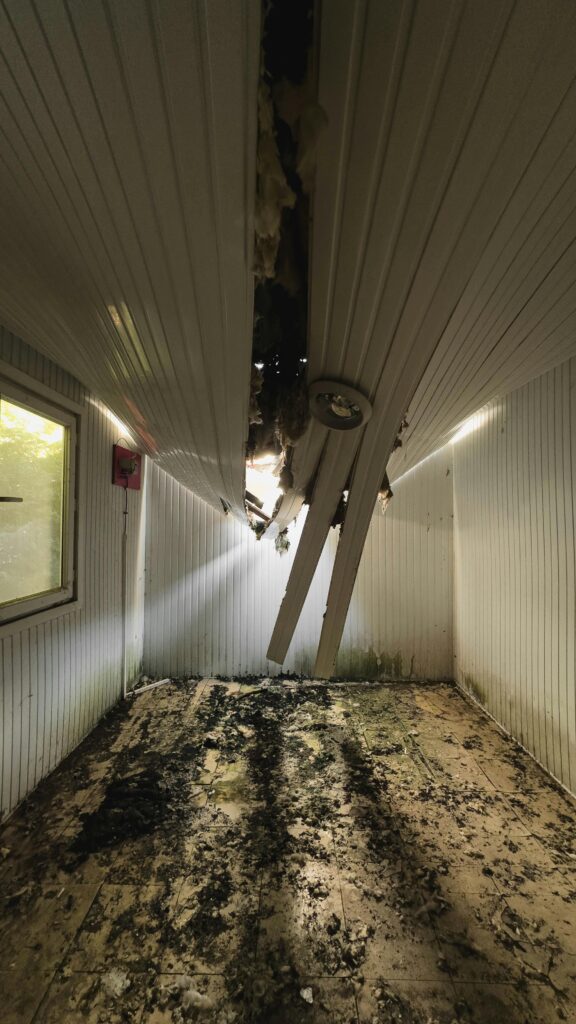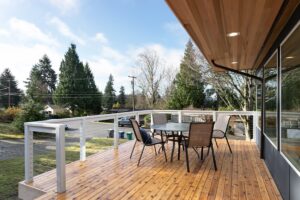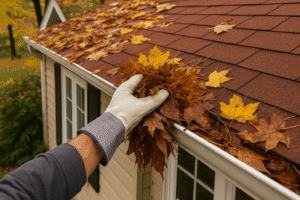If you’ve just noticed a dark stain on your ceiling or a steady drip during the rain, it’s time to act — fast. A roof leak can escalate quickly, causing water damage to insulation, drywall, and even your home’s structure. The good news? Taking the right first steps can minimize damage and buy you time before professional help arrives.
The most important thing to remember when you discover a leak is safety first. Avoid climbing on the roof during bad weather, keep electrical fixtures dry, and contain the leak indoors as soon as possible.
In this guide, we’ll walk you through exactly what to do when your roof starts leaking — from quick fixes you can try immediately to when it’s time to call a Bellevue roofing contractor or Kirkland roofing contractor for a long-term solution. You’ll also learn how to prevent future leaks, understand when repairs aren’t enough, and explore related resources:
- Roof Replacement Cost — learn what factors impact a full roof replacement.
- Emergency Roof Repair Cost — estimate what emergency leak repairs typically cost.
Whether you’re dealing with a minor drip or an active ceiling leak, this quick checklist will help you take control, protect your home, and know when to call in a professional.
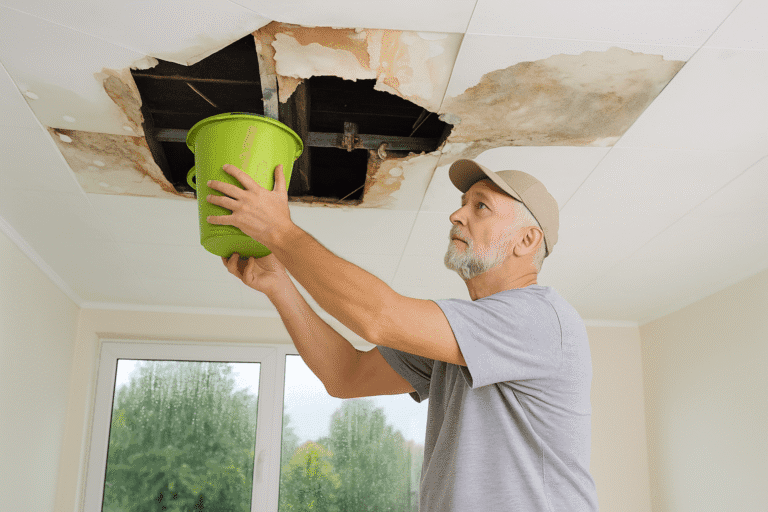
Step 1 – Stay Safe and Contain the Leak
Before you grab your tools or head to the attic, focus on safety first. Roof leaks can create slippery surfaces, electrical hazards, and unstable ceilings — so your first move should always be to secure the area, not fix the problem immediately.
Start by moving furniture, electronics, and valuables out of the affected area to prevent further water damage. Next, place a bucket or large container under the dripping spot to catch the water and reduce ceiling strain. If the ceiling is bulging, carefully poke a small hole to release trapped water and prevent it from collapsing under pressure.
Once you’ve contained the leak, dry the surrounding area using fans or towels to prevent mold and mildew growth. Never climb onto the roof during heavy rain or strong winds — it’s unsafe and rarely effective. Instead, wait for dry conditions or contact a local expert like a Bellevue roofing contractor for a safe inspection once the storm passes.
Step 2 – Find the Source of the Leak
Once the immediate danger is contained, your next step is to locate where the leak is actually coming from. This can be tricky — water often travels along rafters or insulation before dripping into your living space, making the visible spot only a symptom, not the source.
Start by inspecting your attic with a flashlight. Look for water trails, dark stains, or damp insulation on the underside of the roof decking. Follow the trail of moisture upward until you find the highest wet point — that’s usually where the water is entering from above.
Common culprits include:
- Damaged or missing shingles, often displaced during strong winds.
- Cracked or corroded flashing around vents, chimneys, or skylights.
- Clogged gutters, which cause water to back up and seep under roof edges.
- Improperly sealed roof vents that allow moisture to enter.
If you notice widespread damage or multiple leak points, it might be time to evaluate whether a repair or full replacement makes more sense. Our Roof Replacement Cost guide breaks down what to expect based on materials, size, and complexity.
Step 3 – Apply a Temporary Fix
Once you’ve identified where the water is entering, it’s time to control the situation with a temporary roof repair until a professional inspection can take place. Quick action here can prevent thousands of dollars in damage.
Start by covering the damaged area with a heavy-duty tarp, making sure it extends at least a few feet beyond the visible leak. Secure it tightly with nails or weighted boards to prevent wind from lifting it. If the damage is small—like a crack near flashing or a missing shingle—apply roofing sealant or waterproof tape as a short-term patch. These materials are designed to bond even in damp conditions and can buy you enough time to schedule a full repair.
However, it’s important to remember: these are stopgap measures, not permanent fixes. After you stabilize the leak, contact a professional for a full inspection and repair to address underlying structural issues. A licensed Kirkland roofing contractor can ensure the repair meets local code and lasts through future storms.
Related Reading: Emergency Roof Repair Cost
Step 4 – Inspect and Prevent Future Leaks
Once the leak has stopped and your temporary repair is in place, it’s time to look for what caused the problem and how to stop it from happening again. Start with a careful visual check of your roof and gutters once the weather clears. Look for missing or curled shingles, cracked flashing around vents or chimneys, and clogged gutters—all common culprits behind recurring roof leaks.
A good rule of thumb is to perform seasonal roof maintenance twice a year (spring and fall). Clean your gutters, trim overhanging branches, and make sure attic ventilation is working properly to prevent moisture buildup that can lead to mold and wood rot.
For a deeper guide on keeping your roof watertight all year, see our post on Prevent Roof Damage Puyallup.
Step 5 – Know When It’s Time for a Professional
Sometimes, a leak is a symptom of a much bigger issue that quick patches can’t fix. If you notice multiple leaks, sagging roof sections, or signs of structural damage, it’s time to bring in a licensed expert. Other red flags include leaks that keep returning, visible shingle deterioration, or extensive water damage inside your attic or ceilings.
A professional roofer can diagnose the root cause, repair the damage safely, and offer long-term warranties on materials and labor—something DIY fixes can’t provide. For trusted local help, reach out to a certified Bellevue roofing contractor who understands Pacific Northwest weather and roofing materials.
Their inspection not only ensures a permanent repair but can also reveal opportunities to improve ventilation, insulation, and energy efficiency across your roofing system.
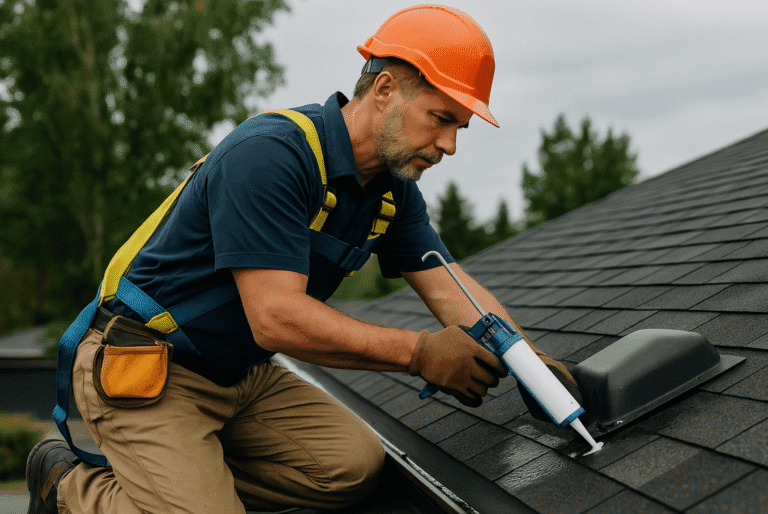
Roof Leak Prevention Checklist (Printable Summary)
Staying ahead of leaks is far easier—and more affordable—than repairing major water damage later. Use this quick, printable checklist to keep your roof in top shape year-round:
✅ Clean gutters twice a year – Prevents water from backing up under shingles.
✅ Trim overhanging tree branches – Avoids debris buildup and shingle damage during storms.
✅ Inspect flashing and vents – Look for cracks or corrosion that can lead to leaks.
✅ Schedule regular roof inspections – Have a professional check your roof every spring and fall.
✅ Address leaks early – Even small drips can turn into major repairs if ignored.
A proactive maintenance routine like this protects your home’s structure, insulation, and interior from costly water damage.
Final Thoughts – Act Fast, Protect Your Home
When it comes to a roof leak, time is everything. The faster you act, the more you can save—both in repairs and peace of mind. Whether it’s a minor drip or a major leak, quick containment followed by a professional inspection ensures your home stays safe and dry through the Pacific Northwest’s toughest weather.
At Orca Roofing & Exteriors, we specialize in fast, high-quality repairs and replacements designed to withstand Puget Sound rainy seasons. Our licensed contractors use premium materials, modern techniques, and a customer-first approach to restore your roof’s integrity and protect your investment.
Don’t wait until the next storm—act today.
Request Free Estimate with our Bellevue Roofing Contractors or Kirkland Roofing Contractors
FAQs: Roof Leak Repair
